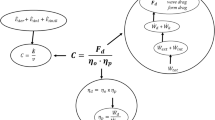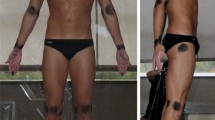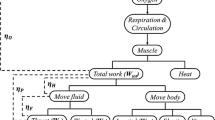Abstract
With the aim of computing a complete energy balance of front crawl, the energy cost per unit distance (C= Ėv−1, where Ė is the metabolic power and v is the speed) and the overall efficiency (ηo=Wtot/C, where Wtot is the mechanical work per unit distance) were calculated for subjects swimming with and without fins. In aquatic locomotion Wtot is given by the sum of: (1) Wint, the internal work, which was calculated from video analysis, (2) Wd, the work to overcome hydrodynamic resistance, which was calculated from measures of active drag, and (3) Wk, calculated from measures of Froude efficiency (ηF). In turn, ηF=Wd/(Wd+Wk) and was calculated by modelling the arm movement as that of a paddle wheel. When swimming at speeds from 1.0 to 1.4 m s−1, ηF is about 0.5, power to overcome water resistance (active body drag × v) and power to give water kinetic energy increase from 50 to 100 W, and internal mechanical power from 10 to 30 W. In the same range of speeds Ė increases from 600 to 1,200 W and C from 600 to 800 J m−1. The use of fins decreases total mechanical power and C by the same amount (10–15%) so that ηo (overall efficiency) is the same when swimming with or without fins [0.20 (0.03)]. The values of ηo are higher than previously reported for the front crawl, essentially because of the larger values of Wtot calculated in this study. This is so because the contribution of Wint to Wtot was taken into account, and because ηF was computed by also taking into account the contribution of the legs to forward propulsion.




Similar content being viewed by others
References
Adrian MJ, Singh M, Karpovich PV (1966) Energy cost of leg kick, arm stroke and whole crawl stroke. J Appl Physiol 21:1763–1766
Alexander RM (1983) Motion in fluids. In: Animal mechanics. Blackwell, Oxford, pp 183–233
Bucher GW (1975) An analysis of arm propulsion in swimming. In: Lewillie L, Clarys JP (eds) Swimming II. University Park Press, London, pp 180–187
Craig AB, Pendergast DR (1979) Relationship of stroke rate, distance per stroke and velocity in competitive swimming. Med Sci Sports Exerc 11:278–283
Craig AB, Skehan PL, Pawelczyk JA, Boomer WL (1985) Velocity, stroke rate and distance per stroke during elite swimming competition. Med Sci Sports Exerc 17:625–634
Daniel T, Jordan C, Grunbaum D (1992) Hydromechanics of swimming. In: Alexander RM (ed) Advances in comparative and environmental physiology 11, Mechanics of animal locomotion. Springer-Verlag, Berlin, pp 17–49
Deschodt VJ, Arsac LM, Rouard AH (1999) Relative contribution of arms and legs in humans to propulsion in 25 m sprint front-crawl swimming. Eur J Appl Physiol 80:192–199
di Prampero PE, Pendergast DR, Wilson D, Rennie DW (1974) Energetics of swimming in man. J Appl Physiol 37:1–5
di Prampero PE (1986) The energy cost of human locomotion on land and in water. Int J Sports Med 7:55–72
Fox RW, McDonald AT (1992) Fluid machines. In: Introduction to fluid mechanics. John Wiley, New York, pp 544–625
Hollander AP, De Groot G, Van Ingen Schenau GJ, Kahman R, Toussaint HM (1988) Contribution of the legs to propulsion in front crawl swimming. In: Ungherects BE, Wilke K, Reischle K (eds) Swimming science V. Human Kinetics, Champaign, Ill., pp 39–43
Lighthill MJ (1975) Hydrodynamics of aquatic animal propulsion: In: Mathematical biofluidodynamics. Society for Industrial and Applied Mathematics, Philadelphia, pp 65–101
Maglischo EW (2003) Swimming fastest. Human Kinetics, Champaign, Ill.
Martin RB, Yeater RA, White MK (1981) A symple analytical model for the crawl stroke. J Biomech 14:539–548
Minetti AE (1998) A model equation for the prediction of mechanical internal work of terrestrial locomotion. J Biomech 31:463–468
Minetti AE, Pinkerton J, Zamparo P (2001) From bipedalism to bicyclism: evolution in energetics and biomechanics of historical bikes. Proc R Soc Lond B Biol Sci 268:1351–1360
Payton CJ, Bartlett RM, Baltzopoulos V, Coombs R (1999) Upper extremity kinematics and body roll during preferred-side breathing and breath-holding front crawl swimming. J Sport Sci 17:689–696
Pendergast DR, Zamparo P, di Prampero PE, Capelli C, Cerretelli P, Termin A, Craig A Jr, Bushnell D, Paschke D, Mollendorf J (2003) Energy balance of human locomotion in water. Eur J Appl Physiol 90:377–386
Toussaint HM (1990) Differences in propelling efficiency between competitive and triathlon swimmers. Med Sci Sports Exerc 22:409–415
Toussaint HM, Beek PJ (1992) Biomechanics of competitive front crawl swimming. Sports Med 13:8–24
Toussaint HM, Knops W, De Groot G, Hollander AP (1990) The mechanical efficiency of front crawl swimming. Med Sci Sports Exerc 22:408–402
Toussaint HM, Janssen T, Kluft M (1991) Effect of propelling surface size on the mechanics and energetics of front crawl swimming. J Biomech 24:205–211
Zamparo P, Pendergast DR, Termin A, Minetti AE (2002) how fins affect the economy and efficiency of swimming. J Exp Biol 205:2665–2676
Acknowledgements
The technical assistance of Dean Marky, Frank Modlich and Chris Eisenhardt is gratefully acknowledged, as well as the patience and kind co-operation of the swimmers. This research has been partially supported by the US Navy, NAVSEA, Navy Experimental Unit, contract N61 33199C0028.
Author information
Authors and Affiliations
Corresponding author
Appendices
Appendix 1
In subjects swimming by using the leg kick, ηF can be assessed by means of methods usually applied to the study of undulating fish (Zamparo et al. 2002), e.g. from measures of the speed of the backward wave travelling along the body and of the forward speed (Alexander 1983; Daniel et al. 1992; Lighthill 1975). The mode of propulsion of the arm stroke is, in contrast, more similar to the one adopted by “rowing” animals that move in water by producing power strokes, during which an appendage is accelerated backwards, and recovery strokes, during which the appendage returns to its original position moving forward (Alexander 1983; Daniel et al. 1992). Rowing animals proceed in water with oscillating speed, i.e. they accelerate in the power stroke and decelerate in the recovery stroke. However, as a first approximation, these oscillations can be considered negligible and the body can be assumed to move forward at constant speed (v) while the appendages move forward and backward with a velocity u relative to the body. As indicated by Alexander (1983) the ratio v/u is proportional to the theoretical (or Froude) efficiency (ηF).
The ratio v/u is directly (or inversely) proportional to the theoretical efficiency in all fluid machines: pumps, turbines, propellers, fans, water wheels and paddle wheels. As an example, the theoretical efficiency of a water wheel can be calculated from the ratio of the tangential velocity of the paddles (the rim speed, u) to the velocity of the headwater stream (v). In this case u is less than v because only a fraction of the kinetic energy of the water (and hence of the power input) goes into shaft power output. On the other hand, the theoretical efficiency of a paddle wheel can be calculated from the ratio of the average velocity of the boat itself (v) to the tangential velocity of the blades (the rim speed, u). In this case v is less than u because only part of the shaft power input goes into “useful” motion, whereas the remaining fraction is wasted in giving “un-useful” energy to the water. Generally speaking, in all turbo-machines, the theoretical (Froude) efficiency depends (among the others) on the velocity components of the fluid and rotor at the inlet and outlet sections (Fox and McDonald 1992).
Humans can be considered as “fluid machines” that obtain the thrust necessary to proceed at a given speed (v) by using two engines: the legs and the arms. As indicated above, for subjects swimming by using the leg kick alone, the term u can be obtained from measures of the speed of the backward wave travelling along the body (as in the case of slender fish). The problem is how to calculate u in the arm stroke. The simplest way to do so is to model the movement of the upper limbs as that of a paddle wheel, a case in which the term u can be easily calculated/estimated from measures of rim speed.
The model presented in this paper is a simplified version of the model proposed by Martin et al. (1981) and considers the arm as a rigid segment rotating at constant angular velocity about the shoulder (see Fig. 5). The model assumes that the body is moving through the water with a constant speed v (metres per second), and that the arms rotate with a stroke rate SF (hertz). As proposed by Martin et al. (1981), it is also assumed that the two arms are 180° out of phase, and that one arm enters the water when the other completes its stroke. Hence, the angular position of the arm is α (α ranges from 0 to π), and the angular speed is: ω=α(t)=2πSF (constant through the cycle), where t is time. The efficiency of this form of propulsion can be calculated as the ratio of useful work rate to total work rate. The useful work rate is given by the product of the propelling force (Fp) times the swimmer’s velocity. In turn, Fp is the horizontal component of the force at the hand (F(α)):
From Newton’s second law (ΣF=mv̇), this force (the thrust) should be equal and opposite to the drag force:
where m is the mass of the swimmer and v̇ his/her acceleration, that is assumed to be zero at constant speed (at steady state). Hence Fp(v)=Fd(v).
The total work rate can be calculated from the product of the moment about the shoulder (F(α) l) and ω:
The instantaneous efficiency is therefore:
Over one “underwater cycle” (from 0 to π), the average efficiency is:
which is equivalent to Eq. 2a reported in the text.
In this last equation, the term (v/2π SF l) is the ratio of forward speed to rim speed (v/u), whereas the term 2/π indicates that only half a cycle (the pushing phase) is made underwater, whereas the recovery phase is made on air. At variance with swimming humans, paddle wheels and water wheels “rotate” outside water and exert a force (at the rim) which is always tangential to the direction of the water stream. In those two cases, the Froude efficiency is indeed given by the ratio v/u. The term 2/π (0.637) indicates that the maximal Froude efficiency of the arm stroke should be less than 1 (ηF=v/u 0.637) since the force exerted by the swimmer has both a horizontal (tangential to the water stream) and a vertical component (not useful for propulsion).
Appendix 2
To estimate the overall efficiency in the front crawl, the combined efficiency of the upper and lower limbs should be computed. This could be done by modelling the swimmer in analogy to a system with two engines/propellers working in parallel: the arms (A) and the legs (L). Since the two engines are not equal, each one will be characterized by its own efficiency (η), power output (PO) and power input (PI):
In these equations, PI and PO stand for mechanical power input and output (the efficiency here is a Froude efficiency) and the effects of a positive/negative influence–interaction between the “two engines/propellers” are not taken into consideration. However, this factor is likely to be partially accounted for by the partitioning in the total propulsion of arms (1−k=0.9) and legs (k=0.1), as experimentally determined by several authors on the basis of independent methods (Bucher 1975; Deschodt et al. 1999; Hollander et al. 1988).
Rights and permissions
About this article
Cite this article
Zamparo, P., Pendergast, D.R., Mollendorf, J. et al. An energy balance of front crawl. Eur J Appl Physiol 94, 134–144 (2005). https://doi.org/10.1007/s00421-004-1281-4
Accepted:
Published:
Issue Date:
DOI: https://doi.org/10.1007/s00421-004-1281-4





